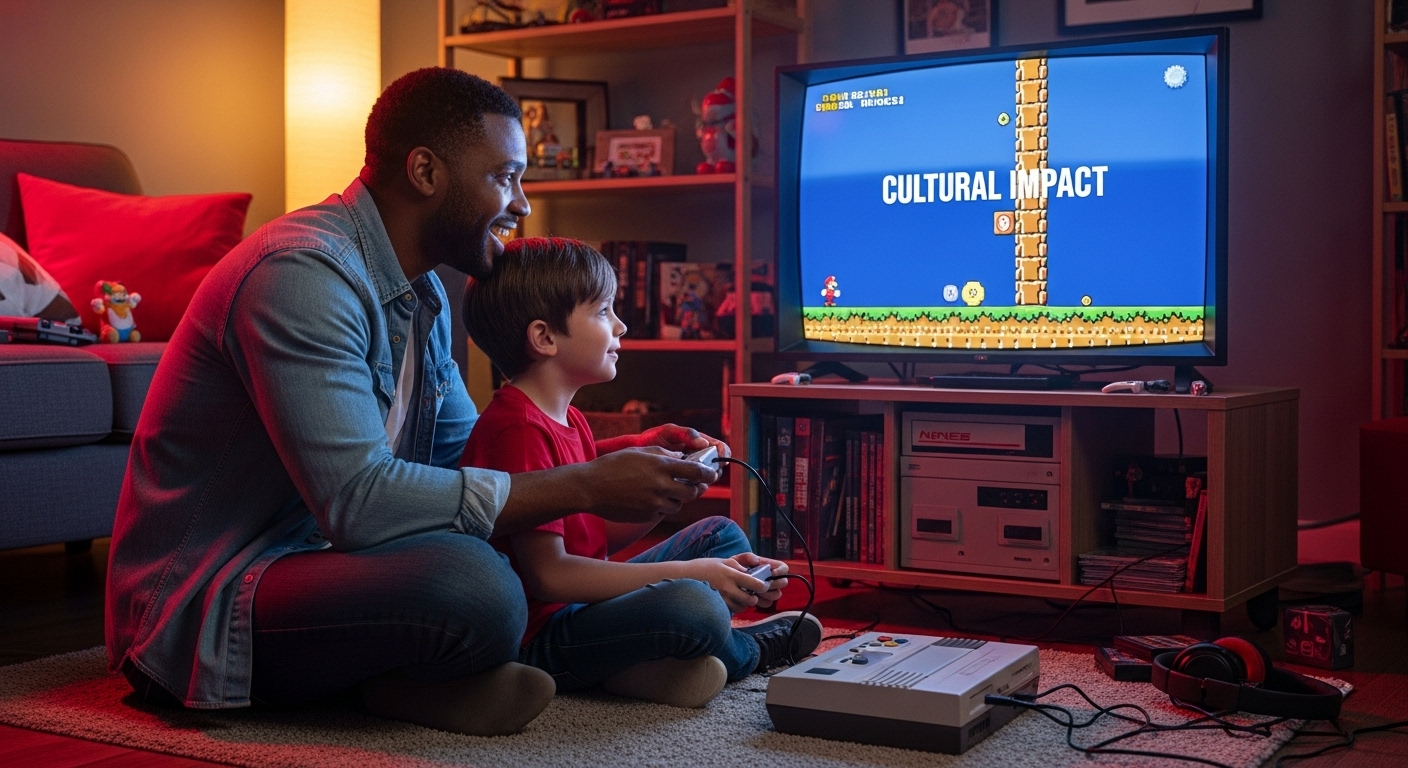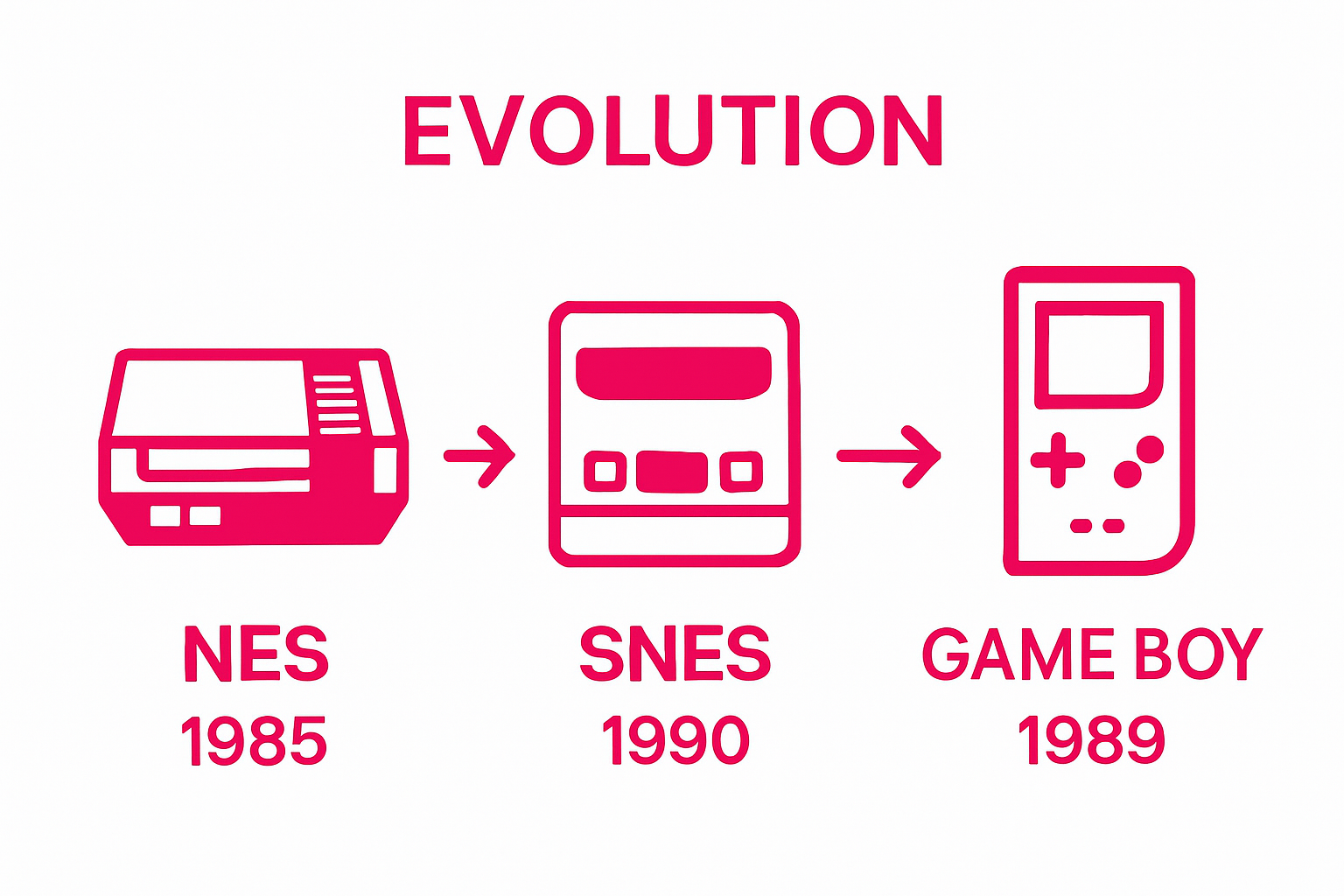
Understanding Classic Nintendo Games: A Nostalgic Journey
Share
Classic Nintendo games are more than old cartridges collecting dust in a cupboard. Some titles have become so valuable that rare editions can sell for thousands of rands, turning childhood favourites into serious collectables. You might think new graphics and advanced consoles would make these relics obsolete, but it’s the simple joy and timeless design of these classics that keep them at the heart of gaming culture today.
Table of Contents
- What Are Classic Nintendo Games And Their Legacy?
- Why Classic Nintendo Games Matter In Today’s Culture
- Key Gameplay Mechanics Of Classic Nintendo Games
- The Evolution Of Classic Nintendo Games And Their Impact
- Collecting And Preserving Classic Nintendo Games
Quick Summary
| Takeaway | Explanation |
|---|---|
| Classic Nintendo games shape modern gaming. | These games introduced key design principles that still influence game development today. |
| Cultural significance transcends generations. | Nintendo games bridge gaps between ages, fostering shared experiences between parents and children. |
| Preservation of game history is crucial. | Collecting and maintaining classic games protects valuable storytelling and technological milestones for future appreciation. |
| Engaging gameplay prioritizes enjoyment over graphics. | Titles like Super Mario Bros demonstrate that effective mechanics and storytelling are essential, regardless of technological advancement. |
| Iconic characters symbolize creativity and storytelling. | Characters like Mario and Link become cultural icons, representing the enduring appeal of interactive narratives. |
What Are Classic Nintendo Games and Their Legacy?
Classic Nintendo games represent a foundational era in video game history that transformed interactive entertainment. These remarkable games, primarily developed between the 1980s and 1990s, established critical design principles and storytelling techniques that continue to influence modern gaming experiences. Understanding the legacy of retro gaming reveals how these titles transcended mere entertainment to become cultural touchstones.
The Golden Age of Nintendo Game Design
The classic Nintendo era introduced groundbreaking game mechanics and iconic characters that would define interactive entertainment. Titles like Super Mario Bros, The Legend of Zelda, and Metroid demonstrated innovative gameplay concepts that were revolutionary for their time. These games introduced players to complex narrative structures, sophisticated level design, and memorable character archetypes that remain influential decades later.
Key characteristics of classic Nintendo games include:
- Precise control mechanics
- Imaginative world-building
- Progressive difficulty levels
- Compelling character narratives
Cultural Impact and Global Significance
According to research from The Conversation, Nintendo transformed video games from niche entertainment into a mainstream cultural phenomenon. Their games bridged generational gaps, creating shared experiences that resonated across different age groups and backgrounds. Mario, Link, and other Nintendo characters became global icons, representing more than just game protagonists but symbols of creativity and interactive storytelling.
The legacy of classic Nintendo games extends far beyond nostalgia. They established fundamental design principles that continue to inspire game developers worldwide, proving that innovative gameplay and imaginative storytelling are timeless qualities that transcend technological limitations.
Below is a comparison table highlighting key features and design principles from the most iconic classic Nintendo franchises mentioned, to provide a quick, scannable reference for readers.
| Franchise | Notable Title(s) | Iconic Feature | Design Approach |
|---|---|---|---|
| Super Mario Bros | Super Mario Bros | Precise platforming | Progressive difficulty, intuitive controls |
| The Legend of Zelda | The Legend of Zelda | Puzzle-solving & quests | Expansive world-building, narrative focus |
| Metroid | Metroid | Exploration & upgrades | Nonlinear gameplay, secret discovery |
| Donkey Kong | Donkey Kong | Barrel jumping action | Early arcade-style challenge |
| Kirby | Kirby’s Adventure | Character transformation | Imaginative mechanics, accessible design |
| Mega Man (Capcom on NES) | Mega Man | Weapon stealing | Tight controls, thematic boss battles |
| Punch-Out!! | Punch-Out!! | Pattern-based boxing | Predictable enemy behaviour, skill mastery |
Why Classic Nintendo Games Matter in Today’s Culture
Classic Nintendo games continue to resonate powerfully in contemporary culture, transcending generational boundaries and maintaining remarkable relevance in an era of hyper-advanced digital entertainment. Explore the world of retro handheld gaming to understand how these timeless experiences connect past and present gaming enthusiasts.
Preserving Gaming Storytelling Fundamentals
Modern video game design often becomes complex, with photorealistic graphics and intricate mechanics. Classic Nintendo games represent a pure, foundational approach to interactive storytelling that prioritizes gameplay enjoyment over technological spectacle. Titles like Super Mario Bros and The Legend of Zelda demonstrate that compelling narratives and engaging gameplay mechanics matter more than graphical complexity.
Key elements that make classic Nintendo games culturally significant include:
- Universal storytelling principles
- Accessible gameplay mechanics
- Emotional connection with characters
- Timeless design philosophy
Nostalgia and Intergenerational Connection
According to research from The Conversation, Nintendo games serve as powerful cultural bridges between generations. Parents who grew up playing these games can now share identical experiences with their children, creating unique bonding opportunities through interactive entertainment. Nostalgia transforms these games from mere digital experiences into shared cultural memories that transcend technological generations.

The enduring appeal of classic Nintendo games lies in their ability to remind players of the pure joy of gaming. They represent a moment in interactive entertainment history where creativity, imagination, and player engagement were paramount, offering a refreshing counterpoint to today’s increasingly complex gaming landscape.
Key Gameplay Mechanics of Classic Nintendo Games
Classic Nintendo games pioneered innovative gameplay mechanics that revolutionized interactive entertainment, establishing fundamental design principles that continue to influence modern game development. Explore the best retro Nintendo consoles to understand the technological platforms that enabled these groundbreaking experiences.
Precision and Predictability in Game Design
Nintendo’s gameplay mechanics were distinguished by their extraordinary precision and intuitive control systems.
Games like Super Mario Bros introduced revolutionary movement mechanics where player actions produced consistent, predictable results. Players could precisely control character jumps, movements, and interactions, creating a sense of mastery and skill progression that was unprecedented in early video game design.
Key characteristics of Nintendo’s gameplay mechanics include:
- Responsive control schemes
- Balanced difficulty progression
- Clear visual feedback
- Intuitive learning curves
Interactive Storytelling Through Gameplay
According to research from The Conversation, Nintendo transformed gameplay from mere button pressing into a narrative experience. Gameplay mechanics became storytelling tools, where player actions directly influenced character progression and world interaction. Titles like The Legend of Zelda demonstrated how exploration, puzzle solving, and combat could seamlessly integrate to create immersive narrative experiences.
The genius of classic Nintendo games lay in their ability to communicate complex narrative and emotional experiences through gameplay mechanics rather than extensive cutscenes or dialogue. Each movement, jump, and interaction became a form of storytelling, allowing players to become active participants in the game’s narrative journey.
The Evolution of Classic Nintendo Games and Their Impact
The journey of classic Nintendo games represents a remarkable narrative of technological innovation and creative storytelling that fundamentally transformed interactive entertainment. Explore plug and play retro gaming essentials to understand how these groundbreaking experiences transitioned through different technological eras.
Technological Progression and Design Innovation
Nintendo’s game evolution can be traced through distinct technological generations, each marked by significant leaps in hardware capabilities and game design philosophy. From the simple pixel graphics of the Nintendo Entertainment System (NES) to the more sophisticated 16-bit Super Nintendo Entertainment System (SNES), each console generation represented a quantum leap in interactive entertainment capabilities.

Key technological milestones in Nintendo’s game evolution include:
- Introduction of scrolling backgrounds
- Enhanced color palettes
- More complex sprite animations
- Improved sound and music capabilities
Cultural and Global Gaming Transformation
According to research from The Conversation, Nintendo did more than create games they fundamentally reshaped global entertainment culture. Game franchises like Mario, Zelda, and Metroid transcended mere digital experiences to become global cultural phenomena, influencing art, music, merchandise, and popular imagination.
The most profound impact of Nintendo’s game evolution was its ability to democratize gaming. By creating experiences that were simultaneously challenging for hardcore players and accessible to newcomers, Nintendo transformed video games from a niche hobby into a mainstream form of entertainment that appealed to diverse age groups and skill levels.
Collecting and Preserving Classic Nintendo Games
Collecting classic Nintendo games represents more than a hobby it is a critical cultural preservation effort that safeguards interactive entertainment history. Master your retro gaming setup to understand the technical nuances of maintaining these precious gaming artifacts.
Preservation Techniques and Authentication
Successful preservation of classic Nintendo games requires specialized knowledge and meticulous care. Collectors must understand the delicate nature of vintage game cartridges, including proper storage conditions, handling techniques, and methods to prevent degradation. Original game cartridges are particularly vulnerable to environmental factors like humidity, temperature fluctuations, and physical damage.
Key preservation strategies include:
- Climate controlled storage environments
- Minimal physical handling
- Using protective cases and sleeves
- Documenting game condition and provenance
The Cultural and Economic Value of Nintendo Game Collections
According to research from The Conversation, classic Nintendo games have transcended their original purpose to become valuable cultural artifacts. Rare game cartridges can appreciate significantly in value, with some limited edition or mint condition games commanding prices in the thousands of rands. This economic potential has transformed game collecting from a niche hobby into a sophisticated form of cultural investment.
Beyond monetary value, collecting Nintendo games preserves interactive storytelling techniques, technological milestones, and artistic expressions that might otherwise be lost to technological obsolescence. Each carefully maintained game cartridge represents a snapshot of gaming history, maintaining the innovative spirit of early video game design for future generations to appreciate and study.
This table summarises the key preservation techniques and economic considerations for classic Nintendo game collecting, serving as a practical guide for South African collectors interested in maintaining the value and heritage of their collections.
| Preservation Technique | Purpose | Economic Benefit |
|---|---|---|
| Climate controlled storage | Prevent cartridge degradation | Maintains or increases resale value |
| Minimal physical handling | Avoids wear and tear | Protects condition for future sales |
| Protective cases and sleeves | Shields from dust and damage | Preserves label quality and collectability |
| Documentation of condition | Verifies authenticity and provenance | Increases buyer confidence and sale prices |
| Authentication of rare editions | Confirms originality | Essential for high-value transactions |
| Regular condition inspections | Early detection of damage | Prevents costly restoration or loss in value |
Bring Your Nintendo Nostalgia to Life with OnlyRetro
Embracing the magic of classic Nintendo games is about more than reminiscing. The article highlighted challenges like keeping the legacy alive, finding authentic retro experiences, and connecting generations through gaming. If you are searching for a way to relive the exact emotions and gameplay fundamentals mentioned – like precise control, timeless design, and storytelling through play – OnlyRetro is here for you.
Rediscover the feeling of true nostalgia today. Our curated collection of retro-inspired tech and accessories helps you preserve those memories and share them with family and friends. Take your interest further by bringing authentic vintage style into your daily life. Ready to start your own journey with the best in retro technology and collectibles? Visit OnlyRetro now for products that bring the spirit of Nintendo classics right into your home. Do not let nostalgia fade – turn your passion into something real this very moment.
Frequently Asked Questions
What are classic Nintendo games?
Classic Nintendo games refer to video games developed by Nintendo primarily between the 1980s and 1990s, such as Super Mario Bros, The Legend of Zelda, and Metroid. These games pioneered innovative gameplay mechanics and storytelling techniques, leaving a lasting legacy in the video game industry.
Why are classic Nintendo games still relevant today?
Classic Nintendo games remain relevant due to their universal storytelling principles, accessible gameplay mechanics, and emotional connections with characters. They serve as cultural bridges across generations, allowing players of all ages to enjoy shared gaming experiences.
What gameplay mechanics did classic Nintendo games introduce?
Classic Nintendo games introduced key gameplay mechanics such as precise control schemes, balanced difficulty progression, and intuitive learning curves. These mechanics allowed players to master skills and experience a deep sense of accomplishment as they progressed through the games.
How can collectors preserve classic Nintendo games?
Collectors can preserve classic Nintendo games by using climate-controlled storage environments, minimizing physical handling, employing protective cases, and documenting the condition of their game cartridges. This careful preservation ensures that these cultural artifacts remain in excellent condition for future generations.
Recommended
- 7 Best Retro Nintendo Consoles for Nostalgic Gamers – OnlyRetro
- Understanding Why is Retro Gaming So Popular – OnlyRetro
- Understanding Retro Handheld Game Console: Nostalgia Explained – OnlyRetro
- 7 Essentials for Choosing Plug and Play Retro Games – OnlyRetro